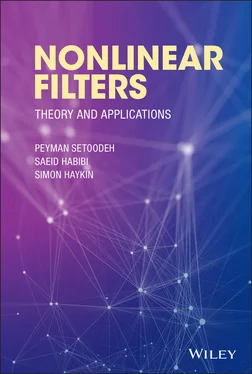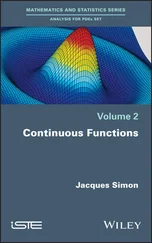Simon Haykin - Nonlinear Filters
Здесь есть возможность читать онлайн «Simon Haykin - Nonlinear Filters» — ознакомительный отрывок электронной книги совершенно бесплатно, а после прочтения отрывка купить полную версию. В некоторых случаях можно слушать аудио, скачать через торрент в формате fb2 и присутствует краткое содержание. Жанр: unrecognised, на английском языке. Описание произведения, (предисловие) а так же отзывы посетителей доступны на портале библиотеки ЛибКат.
- Название:Nonlinear Filters
- Автор:
- Жанр:
- Год:неизвестен
- ISBN:нет данных
- Рейтинг книги:5 / 5. Голосов: 1
-
Избранное:Добавить в избранное
- Отзывы:
-
Ваша оценка:
- 100
- 1
- 2
- 3
- 4
- 5
Nonlinear Filters: краткое содержание, описание и аннотация
Предлагаем к чтению аннотацию, описание, краткое содержание или предисловие (зависит от того, что написал сам автор книги «Nonlinear Filters»). Если вы не нашли необходимую информацию о книге — напишите в комментариях, мы постараемся отыскать её.
Discover the utility of using deep learning and (deep) reinforcement learning in deriving filtering algorithms with this insightful and powerful new resource Nonlinear Filters: Theory and Applications
Nonlinear Filters
Nonlinear Filters: Theory and Applications
Nonlinear Filters — читать онлайн ознакомительный отрывок
Ниже представлен текст книги, разбитый по страницам. Система сохранения места последней прочитанной страницы, позволяет с удобством читать онлайн бесплатно книгу «Nonlinear Filters», без необходимости каждый раз заново искать на чём Вы остановились. Поставьте закладку, и сможете в любой момент перейти на страницу, на которой закончили чтение.
Интервал:
Закладка:
The second part of the book is dedicated to machine learning‐based filtering algorithms. Basic learning algorithms, deep learning architectures, and variational inference are reviewed to lay the groundwork for such algorithms. Different deep learning‐based filters have been developed, which deploy supervised or unsupervised learning. These filters include deep Kalman filter, backpropagation Kalman filter, differentiable particle filter, deep Rao–Blackwellized particle filter, deep variational Bayes filter, Kalman variational autoencoder, and deep variational information bottleneck. Wasserstein distributionally robust Kalman filter and hierarchical invertible neural transport are presented in addition to the mentioned filtering algorithms. Expectation maximization allows for joint state and parameter estimation. Different variants of expectation maximization algorithm are implemented using particles, Gaussian mixture models, deep neural networks, relational deep neural networks, variational filters, and amortized variational filters. Variational inference and reinforcement learning can be viewed as instances of a generic expectation maximization problem. As a result, (deep) reinforcement learning methods can be used to develop novel filtering algorithms. Finally, the book covers nonparametric Bayesian models. In addition to reviewing measure‐theoretic probability concepts and the notions of exchangeability, posterior computability, and algorithmic sufficiency, guidelines are provided for constructing nonparametric Bayesian models from parametric ones.
This book reviews a wide range of applications of classic and machine learning‐based filtering algorithms regarding COVID‐19 pandemic, influenza incidence, prediction of drug effect, robotics, information fusion, augmented reality, battery state‐of‐charge estimation for electric vehicles, autonomous driving, target tracking, urban traffic network, cybersecurity and optimal power flow in power systems, single‐molecule fluorescence microscopy, and finance.
P. Setoodeh, S. Habibi, and S. Haykin
Hamilton, Ontario, Canada
January 2022
Acknowledgments
We would like to express our deepest gratitude to several colleagues, who helped us in one form or another while writing this book: Dr. Mehdi Fatemi, Dr. Pouya Dehghani Tafti, Dr. Ehsan Taghavi, Dr. Andrew Gadsden, Dr. Hamed Hossein Afshari, Dr. Mina Attari, Dr. Dhafar Al‐Ani, Dr. Ulaş Güntürkün, Dr. Yanbo Xue, Dr. Ienkaran Arasaratnam, Dr. Mohammad Al‐Shabi, Dr. Alireza Khayatian, Dr. Ali Akbar Safavi, Dr. Ebrahim Farjah, Dr. Paknoosh Karimaghaee, Dr. Mohammad Ali Masnadi‐Shirazi, Dr. Mohammad Eghtesad, Dr. Majid Rostami‐Shahrbabaki, Dr. Zahra Kazemi, Dr. Farshid Naseri, Dr. Zahra Khatami, Dr. Mohsen Mohammadi, Dr. Thiagalingam Kirubarajan, Dr. Stergios Roumeliotis, Dr. Magnus Norgaard, Dr. Eric Foxlin, Dr. Maryam Dehghani, Dr. Mohammad Mehdi Arefi, Dr. Mohammad Hassan Asemani, Dr. Mohammad Mohammadi, Dr. Mehdi Allahbakhshi, Dr. Haidar Samet, Dr. Mohammad Rastegar, Dr. Behrooz Zaker, Dr. Ali Reza Seifi, Dr. Mahdi Raoofat, Dr. Jun Luo, and Dr. Steven Hockema.
Last but by no means least, we would like to thank our families. Their endless support, encouragement, and love have always been a source of energy for us.
P. Setoodeh, S. Habibi, and S. Haykin
Acronyms
Backprop KFbackpropagation Kalman filterBMSbattery management systemsCKFcubature Kalman filterCNNconvolutional neural networkCRLBCramér–Rao lower boundDDFdivided‐difference filterDKFdeep Kalman filterDRBPFdeep Rao–Blackwellized particle filterDVBFdeep variational Bayes filterDVIBdeep variational information bottleneckEKFextended Kalman filterELBOevidence lower boundEMexpectation maximizationFATEfairness, accountability, transparency, and ethicsGANgenerative adversarial networkGRUgated recurrent unitHINThierarchical invertible neural transportIBinformation bottleneckIMMinteracting multiple modelISimportance samplingKFKalman filterKLDKullback–Leibler divergenceKVAEKalman variational autoencoderLSTMlong short‐term memoryLTIlinear time‐invariantLTVlinear time‐varyingMAPmaximum a posterioriMCMCMarkov chain Monte CarloMDPMarkov decision processMLmaximum likelihoodMMSEminimum mean square errorMPFmarginalized particle filterN‐EMneural expectation maximizationNIBnonlinear information bottleneckNLLnegative log likelihoodPCRLBposterior Cramér–Rao lower boundPDFprobability distribution functionP‐EMparticle expectation maximizationPFparticle filterPIDproportional‐integral‐derivativePOMDPpartially‐observable Markov decision processRBPFRao‐Blackwellised particle filterReLUrectified linear unitR‐NEMrelational neural expectation maximizationRNNrecurrent neural networkSGVBstochastic gradient variational BayesSIRsampling importance resamplingSLAMsimultaneous localization and mappingSMAUGsingle molecule analysis by unsupervised Gibbs samplingSMCsequential Monte CarloSoCstate of chargeSoHstate of healthSVSFsmooth variable‐structure filterTD learningtemporal‐difference learningUIOunknown‐input observerUKFunscented Kalman filterVAEvariational autoencoderVFEMvariational filtering expectation maximizationVSCvariable‐structure controlwILIweighted influenza‐like illness
1 Introduction
1.1 State of a Dynamic System
In many branches of science and engineering, deriving a probabilistic model for sequential data plays a key role. System theory provides guidelines for studying the underlying dynamics of sequential data (time series). In describing a dynamic system, the notion of state is a key concept [1]:
Definition 1.1 State of a dynamic system is the smallest collection of variables that must be specified at a time instant in order to be able to predict the behavior of the system for any time instant . To be more precise, the state is the minimal record of the past history, which is required to predict the future behavior.
According to the principle of causality , any dynamic system may be described from the state perspective. Deploying a state‐transition model allows for determining the future state of a system,  , at any time instant
, at any time instant  , given its initial state,
, given its initial state,  , at time instant
, at time instant  as well as the inputs to the system,
as well as the inputs to the system,  , for
, for  . The output of the system,
. The output of the system,  , is a function of the state, which can be computed using a measurement model. In this regard, state‐space models are powerful tools for analysis and control of dynamic systems.
, is a function of the state, which can be computed using a measurement model. In this regard, state‐space models are powerful tools for analysis and control of dynamic systems.
1.2 State Estimation
Observability is a key concept in system theory, which refers to the ability to reconstruct the hidden or latent state variables that cannot be directly measured, from the measured variables in the minimum possible length of time [1]. In building state‐space models, two key questions deserve special attention [2]:
1 (i) Is it possible to identify the governing dynamics from data?
Читать дальшеИнтервал:
Закладка:
Похожие книги на «Nonlinear Filters»
Представляем Вашему вниманию похожие книги на «Nonlinear Filters» списком для выбора. Мы отобрали схожую по названию и смыслу литературу в надежде предоставить читателям больше вариантов отыскать новые, интересные, ещё непрочитанные произведения.
Обсуждение, отзывы о книге «Nonlinear Filters» и просто собственные мнения читателей. Оставьте ваши комментарии, напишите, что Вы думаете о произведении, его смысле или главных героях. Укажите что конкретно понравилось, а что нет, и почему Вы так считаете.












